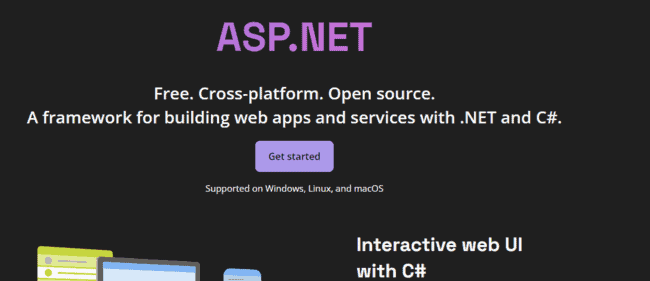Web frameworks have become indispensable tools for modern web development. It provides web developers with the tools. It helps them to build scalable and robust web applications.
A website framework is a software framework. It helps to simplify the development of web services and web applications. It provides a standard way to build and deploy them. Today, there are numerous web frameworks available to coders. Each has its own set of features and capabilities. We will explore the top 10 web frameworks for modern development.
These web frameworks have been chosen for their popularity. Also their ease of use, and robustness. It makes them ideal for building a wide range of web applications. These web frameworks can help you build high-quality web applications. No matter whether you are a beginner or an experienced web developer. So, let’s dive in and explore the top 10 web frameworks for modern development!
The Importance of The Web Frameworks

A man working on web development framework.
Web frameworks have revolutionized the world of web development. It provides coders with a standardized and streamlined approach. It helps to build web applications. These frameworks come equipped with a variety of features and tools. That makes it easier for coders to create high quality web applications.
Web frameworks simplify the development process. This is one of the most significant advantages of them. It provides a set of predefined rules and guidelines for structuring an application. This allows coders to focus on the unique features of their applications.
With a web development framework, coders can easily build web applications. They use pre built components, libraries, and modules. This saves time and effort and reduces the risk of errors and bugs.
They make it easier for coders to maintain and update their applications. It is another important advantage of web frameworks. Web frameworks typically have built in support for version control. That allows coders to track changes to their codebase. It also collaborates with other coders more efficiently. This makes it easier to keep the codebase up to date. It ensures that the application is running smoothly.
To simplify the development process, web frameworks also play a crucial role in the security of a web application. Web frameworks come equipped with a variety of built in security features. For example, authentication and authorization mechanisms. It helps to protect against common security threats. This reduces the risk of security breaches. It also ensures that user data remains safe and secure.
Web frameworks also make it easier for coders. They can build applications that are scalable and flexible. Coders can easily add new features and functionality to their applications. This allows a web application to evolve over time and adapt to the changing needs of users.
Some of The Best Web Development Frameworks
There are many web development frameworks available. From them, here are some of the best web development frameworks. Choose the right web development framework that suits you.
Django
Django is a popular Python-based website framework. It helps coders to build complex and high performing web applications. It provides a full stack framework. A web developer can build a web application, from the front end to the back end. Django is designed to be simple, flexible, and fast. That makes it an ideal choice for web developers who need to build web services or website resources quickly.
Key Features and Advantages
Django has a range of features. It has some advantages that make it a top choice for web developers. Some of its key features include its built in admin interface and robust security features. It also supports various databases. Additionally, Django offers automatic URL routing. It also offers an Object-Relational Mapping (ORM) layer. It supports multiple languages.
Use Cases and Examples of Sites Built with Django
Django has been used to build a wide range of sites and applications. That includes social media platforms, content management systems, and e commerce sites. Some notable examples of sites built with Django include Instagram, Pinterest, and Mozilla.
Limitations and Potential Drawbacks
One of the potential drawbacks of Django is its complexity. That can make it challenging for novice web developers to get started. Additionally, Django can be resource intensive. That can result in slower performance if not properly optimized. Another limitation of Django is its reliance on backend frameworks. It can be a barrier for some web developers who prefer front end development.
Ruby on Rails

Ruby on Rails, also known as simply Rails, is a popular web development framework written in Ruby. It follows the Model-View-Controller (MVC) architectural pattern. It is designed to make web development easier and faster. Rails emphasize convention over configuration. It means that coders don’t have to spend a lot of time configuring their projects before they can start building.
Key Features and Advantages
Ruby on Rails offers a wide range of features and advantages that make it a top choice for web developers. It has built in features, such as automatic scaffolding. That makes it easy to get started and build web applications quickly. Rails also has a strong community of coders who contribute to its open source codebase. They offer support to other coders.
Use Cases and Examples of Sites Built with Ruby on Rails
Ruby on Rails has been used to build a variety of sites, from social media platforms to e commerce sites. Some notable examples of sites built with Rails include Airbnb, GitHub, and Shopify. It is flexible and easy to use. That’s why a lot of people in the web development industry use it. With it, they can quickly and efficiently build web resources or applications.
Limitations and Potential Drawbacks
One potential drawback of Ruby on Rails is its steep learning curve. While it is designed to make web development easier, it can still take time for coders to get comfortable with its conventions and syntax. Additionally, Rails can be resource intensive. It can result in slower performance if not properly optimized. Its reliance on third party plugins and gems can make it difficult to keep up with updates and security patches.
Angular
Angular is a popular open source web development framework used for building a web application. It is a TypeScript based website framework developed and maintained by Google. Angular is known for its focus on building dynamic, single page applications. It has smooth and interactive user interfaces.
Key Features and Advantages
One of the key advantages of Angular is its robustness and scalability. It is a comprehensive web framework. It provides coders with everything they need to build a complex web application. Angular also offers a component based architecture. It helps to make development more organized and efficient. Dependency injection, easy data binding, and built in testing capabilities are some other advantages.
Use Cases and Examples of Sites Built with Angular
Angular has been used to build a wide range of web apps. It starts from small business sites to large enterprise applications. Some notable examples of sites built with Angular include Forbes, Microsoft Office, and Upwork. Angular is particularly well suited for building single page applications with interactive user interfaces.
Limitations and Potential Drawbacks
One potential drawback of Angular is its steep learning curve. Its comprehensive nature can be overwhelming for beginners. It may take some time to become proficient with the web framework. Additionally, Angular is a large web framework. That can make it slower to load compared to some other web development frameworks. Because Angular is a Google product, some coders may be concerned about vendor lock-in.
React
To create user interfaces, many coders turn to the famous open source JavaScript package known as React. Facebook developed it, and it is now maintained by a large community of coders. The adaptability and reusability of React have made it popular. That makes it a popular choice for building complex web applications.
Key Features and Advantages
React’s component based design is a major selling point. That makes it easy to reuse and maintain code. React also offers a virtual DOM. That improves performance by reducing the number of updates required to the actual DOM. Another advantage of React is its compatibility with other web development frameworks and programming languages. That’s why it’s such a useful tool for software engineers.
Use Cases and Examples of Sites Built with React
React has been used to build a wide range of web applications. It starts from small websites to large scale enterprise applications. Some notable examples of sites built with React include Facebook, Instagram, and Netflix. React is particularly well suited for building user interfaces and single page applications with complex interactions.
Limitations and Potential Drawbacks
One potential drawback of React is its steep learning curve. It is particularly for coders new to the library. React is a library and not a full fledged web development framework. So, coders may need to rely on other libraries and tools to build complete web apps. Because Facebook develops React, some coders may be concerned about vendor lock in.
Vue.js

A Developer picks the logo of Vue.js framework.
Vue.js is a progressive JavaScript framework. Coders use it for building user interfaces and single page applications. Evan you developed it, and it is now maintained by a large community of coders. Vue.js is simple and easy to use. That makes it a popular choice for web developers.
Key Features and Advantages
Vue.js is its flexibility and lightweight nature. This is one of the key advantages. That makes it easy to integrate with existing web applications. Vue.js also offers a simple and intuitive syntax. That makes it a breeze to pick up and use for any programmer. Additionally, Vue.js provides a powerful set of tools. It helps to build reactive and dynamic web pages.
Use Cases and Examples of Sites Built with Vue.js
Vue.js has been used to build a variety of web applications. Some notable examples of sites built with Vue.js include Alibaba, Xiaomi, and Grammarly. Vue.js is particularly well suited for building single page applications.
Limitations and Potential Drawbacks
One potential limitation of Vue.js is its smaller community compared to other web frameworks. This can make it more difficult to find web resources. It is difficult to support more complex web development projects. Vue.js may not be the best choice for building large scale web applications. It requires complex data management and processing.
Flask
Flask is a micro web framework written in Python. Web applications may be developed rapidly and easily with its help. It is a lightweight and flexible framework. It does not require any particular tools or libraries to be installed. That makes it an ideal choice for smaller projects or prototypes.
Key features and advantages
Flask’s simplicity and flexibility are some of its main advantages. It does not enforce any particular way of structuring applications. It also does not require coders to use specific libraries or tools. This allows coders to customize and optimize a web application to meet their specific needs.
Flask also has a small footprint and requires minimal setup, making it easy to learn and use. It comes with built in support for unit testing and debugging. It also comes with integration with popular web development tools. For example, Jinja2, SQLAlchemy, and WTForms.
Use cases and examples of sites built with Flask
Flask is a popular choice for building web applications. It is best for those with simple requirements. It has been used to build a variety of services. That includes blogs, online marketplaces, and news websites. Some popular examples of sites built with Flask include Pinterest, Twilio, and LinkedIn Learning.
Limitations and potential drawbacks
Flask may not be as suitable for larger or more complex projects as other web frameworks. This is one of the potential drawbacks of it. Its simplicity and flexibility can also be a double edged sword. It may require more effort and decision making on the part of coders to build and maintain a robust and scalable web application. Flask’s small community size may make finding support and resources more challenging.
Express.js
Express.js is a popular, lightweight web development framework for Node.js. It’s a powerful backend JavaScript runtime environment. It is designed to build scalable and fast web applications with a minimalist approach. Express.js provides coders with a flexible and robust set of features. It helps them to build complex web applications with ease.
Key features and advantages
Express.js is known for its simplicity and flexibility. That makes it a popular choice for web developers. The following are examples of its salient characteristics and benefits:
Routing: Express.js makes it easy to define routes and handle HTTP requests.
Middleware support: Coders can use middleware functions to add custom functionality to their applications.
Template engines: Express.js supports multiple template engines, including Pug, EJS, and Handlebars.
Database integration: It offers seamless integration with popular databases. For example, MongoDB, MySQL, and PostgreSQL.
Scalability: Express.js is highly scalable. That makes it ideal for building large scale website applications.
Use cases and examples of sites built with Express.js
Express.js is used by a wide range of companies and organizations to build web apps. Some popular examples include Trello, MyFitnessPal, and IBM.
Limitations and potential drawbacks
While Express.js is famous for its simplicity and flexibility, it does have some limitations. It lacks the sophistication of competing web development frameworks. It may not be the best choice for building complex web apps that require extensive business logic. Additionally, coders may need to rely on third party packages for certain functionality. It can add complexity to their codebase.
ASP.NET

Microsoft’s ASP.NET is an open source framework for building server side web applications. It allows web developers to build dynamic websites, web applications, and services. The CLR is the foundation upon which ASP.NET was constructed. That is responsible for managing code execution in the .NET framework.
Key features and advantages
There is a wide variety of resources available to coders thanks to ASP.NET. This is one of the key advantages of it. It helps to build complex web apps. It supports a variety of programming languages. That includes C#, VB.NET, and F#. Additionally, it includes features such as automatic memory management, security, and debugging tools.
Another advantage of ASP.NET is its scalability. It allows coders to easily add new features and functionality as their web apps grow and evolve. Additionally, ASP.NET works well with other Microsoft products. For example, SQL Server and Azure. That makes it a popular choice for enterprise level applications.
Use cases and examples of sites built with ASP.NET
A wide range of organizations and websites use ASP.NET. Some popular examples of sites built with ASP.NET include Microsoft’s own website, GoDaddy, and Dell. It is also commonly used in industries such as healthcare, finance, and government.
Limitations and potential drawbacks
One potential cons of ASP.NET is that it can be more complex and difficult to learn compared to some other web frameworks. It requires coders to have a solid understanding of the .NET framework and its associated technologies. Another potential limitation is that it may not be the best choice for small, simple web apps. It can be overkill in terms of options and functionality.
Laravel
Laravel is an open source PHP web structure that is for application development. Taylor Otwell developed it. It has rapidly risen to prominence as a top PHP framework. Laravel has elegant syntax, expressive code, and a coder friendly environment. Laravel follows the Model-View-Controller (MVC) architectural pattern. It provides a wide range of options and tools. It helps coders to build scalable, secure, and maintainable applications.
Key features and advantages
Laravel offers a variety of key features and advantages for coders. It provides a robust routing system, easy database migrations, and integrated unit testing support. It also provides a powerful templating engine called Blade. Laravel offers a built in authentication system. This facilitates control over who has access to what. Other key features include built in support for queuing and task scheduling. It has real time event broadcasting and easy integration with popular frontend JavaScript frameworks.
Use cases and examples of sites built with Laravel
Many different kinds of programs you can find with Laravel. It starts from simple blogs and content management systems to complex e commerce platforms. Examples of sites built with Laravel include Laravel.io, a community driven site for Laravel coders. Envoyer.io, a continuous deployment platform, and Laravel Spark, a SaaS starter kit for building subscription based applications.
Limitations and potential drawbacks
Laravel offers many advantages for web application development. It has also some limitations and potential drawbacks. Since it is built on PHP, Laravel may not be as performant as some other web specific languages. The documentation for Laravel is extensive. There may be a learning curve for coders who are not already familiar with PHP and the Laravel framework. Since Laravel is a newer structure, there may be a smaller community of coders.
Spring

Spring is a popular web application development structure for Java. Developers use it to build complex and scalable website applications. It has several useful options and tools for coders. It helps to build website applications. That includes robust support for dependency injection, web services, and database integration. Spring has become one of the most popular web development structures.
Key features and advantages
Spring offers a number of key features and advantages for web application development. One of the most notable is its support for dependency injection. It allows coders to easily manage object dependencies and improve application modularity.
Spring also provides support for web services and RESTful APIs. That makes it a powerful choice for building web based APIs and microservices. Additionally, Spring’s integration with popular databases like MySQL and PostgreSQL. That makes it easy to work with data in a variety of different contexts.
Use cases and examples of sites built with Spring
A wide range of applications can build with Spring. Some popular examples of sites built with Spring include LinkedIn, Ticketmaster, and Netflix.
Limitations and potential drawbacks
Besides its benefits, it does have some limitations and potential cons. One of the main criticisms of Spring is that it can be complex to set up and configure. Particularly for coders who are new. Additionally, while Spring provides a wide range of options and tools, it may not be the best choice for all web development use cases.
Conclusion
Web frameworks play a vital role in the development of modern day website applications. With the help of these structures, web developers can build complex and robust applications.
We have discussed ten of the most popular web frameworks. Each with its own unique options, advantages, limitations, and use cases. From the backend frameworks to the frontend frameworks, these structures provide coders with the tools. It helps them to create dynamic and engaging website applications.
Moreover, the availability of web-specific languages, web templates, and programming languages enables web developers to develop applications with ease. The use of these structures and web resources can also aid in the creation of responsive and scalable web pages. It reduces the burden on coders and allows them to focus on the business logic of their applications.
